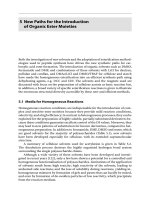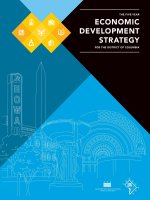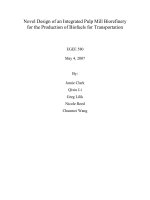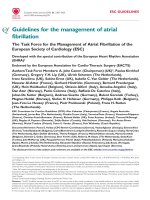- Trang chủ >>
- Đề thi >>
- Đề thi lớp 5
On sufficient conditions for the sum of two weak closed convex sets to be weak closed
Bạn đang xem bản rút gọn của tài liệu. Xem và tải ngay bản đầy đủ của tài liệu tại đây (178.75 KB, 3 trang )
<span class='text_page_counter'>(1)</span>Arch. Math., Vol. 48, 328-330 (1987). 0003-889 X/87/4804-0328 $ 2.10/0 9 1987 Birkh/iuser Verlag, Basel. O n sufficient c o n d i t i o n s for the sum of two w e a k 9 closed convex sets to be w e a k 9 closed By M. ALI KHAN and RMIV VOI-IRA*). 1. The question as to when the sum of two closed sets is closed arises naturally in applied mathematics and is of interest in its own right. For subsets of an infinite dimensional space, answers to this question have been given by Choquet [1], K y Fan [3], Dieudonn+ [2] and more recently by Jameson [4]. Ky Fan, in particular, has shown that the sum of two weakly closed convex subsets of a locally convex topological vector space is weakly closed under a condition that takes account of the mutual position of the two sets. In this note, we offer another sufficient condition of this genre for subsets in the dual of a locally convex topological vector space. Despite its simplicity, this result seems to have been overlooked in the literature. We also give simple examples which bring out the difference between our sufficient condition and those of the others. It is worth mentioning that our result is directly inspired by a problem in mathematical economies, see [5]. 2. Let (E, z) be a real, Hausdorff locally convex vector space and E' its topological dual, i.e., the space of all z-continuous linear functions on E. a (E', E) denotes the weak 9 topology on E'. Following [6, Definition 12-3-7], we say that E is strictly hypercomplete if for any S c E', S n U ~ is weak 9 compact implies S is weak 9 closed, where U ~ is the polar of any neighborhood of zero in E. We can now state Theorem. Let X and Y be two a(E', E)-closed, convex subsets of E' such that X c~ ( - Y + U ~ is z-equicontinuous for any neighborhood U of zero in E. I f E is strictly hypercomplete, then X + Y is a (E', E)-closed. Proof. Let W = X + Y and for any neighborhood U of zero in E, let W, = (X + Y) c~ U ~ Given Alaoglu-Bourbaki theorem, the strict hypercompleteness of E and the convexity of X and Y, we need only show that W,, is a (E', E)-closed. Towards this end, pick any net {wv} from W, and such that the a (E', E) limit of {wv} is w. For each w v, there exist x v e X, y~ ~ Ysuch that x ~ + y~ = w ~. Under the hypothesis of the theorem, this implies that {x v} lie in a z-equicontinuous set. By a second application of MaogluBourbaki, we can assert the existence of a subnet {x ~} which tends in a (E', E) to a limit, *) This research was supported, in part, by a NSF grant to Brown University..
<span class='text_page_counter'>(2)</span> Vol. 48, 1987. Sum of two weak 9 closed convex sets. 329. say x. Since X is ~ (E', E)-closed, x ~ X. Furthermore, since yVe = wVe _ x~O,y~O also tends in cr (E', E) to a limit, say y. Since Y is tr (E', E)-closed, y ~ Y. Certainly y = w - x which implies that w s W, and the p r o o f is finished. [] Corollary. The theorem is true if E is assumed, in addition, to be quasibarrelled and the condition X • ( - Y + U ~ is z-equicontinuous is weakened to the requirement that it be fl (E', E)-bounded, where fl denotes the strong topology. P r o o f. Given the definition of quasibarrelled [6; Definition 10-I-7 and Theorem 10-1-11], an obvious modification in the p r o o f of the theorem yields the corollary. [] 3. We now present six examples to relate our result to previous work. O u r first two examples are taken from K y Fan. Example 1. In the Euclidean plane R 2, let X = { ( a l , a z ) e R 2 : a 1 > O, a l a 2 > 1} and Y = {(a 1, a2)E R2: --oO < a 1 < 0% a 2 -----0}. In the context of our theorem X + Y cannot be shown to be closed since X n (Y + S) or Y n ( - X + S) is not a compact set, where S denotes the closed unit ball in R 2. N o t e that K y F a n ' s reason for X + Y not being closed is that the interior of X ~ does not intersect y 0 E x a m p 1 e 2. Let X be as in Example I but Y = {(al, a2) ~ R2: a 1 + a2 = 0}. X + Y is closed since X n (Y + k S) is compact for any positive real n u m b e r k. This example also satisfies the sufficiency conditions of the results of K y F a n and Dieudonn6 but not for that of Choquet. Example 3. L e t X = {(al,a2)~R2: - ~ < aa <o%a2 = 0 } a n d Y = {(aa,a2)~R2: ~ < a2 < o% a 1 = 0}. Since X ~ and yO have empty interiors in R 2, we cannot apply K y F a n ' s Theorem 2. Since X and Y are not subsets of a convex set that contains no straight line, we cannot apply Choquet's result either. However (X + Y) is closed as a consequence of our theorem, since X n (Y + S) is compact. N o t e that this example also satisfies the sufficiency conditions of Dieudonn6's result. Next, we present an example that does not satisfy any of the sufficient conditions required by the results in [1], [2] or [3] but does satisfy those required for our theorem. -. E x a m p 1 e 4. In the space #~o, let X and Y be the positive cone {a ~ f ~ : al > 0}. X 0 = y o = {a ~ d~: a i < 0}. Since the positive cone in f l has an e m p t y n o r m interior and the n o r m topology is identical to the M a c k e y t o p o l o g y z ( f l , d~o), we cannot appeal to K y F a n ' s theorem to assert the closedness o f X + Y. Dieudonn6's theorem does not apply since X and Y are not locally compact. Since E~ is not weakly complete, neither are X and Y and thus Choquet's result does not apply. However, X + Y is closed as a consequence of our theorem since X n ( - Y + U ~ is a (E ~ f~) compact for any zero neighborh o o d U in d~. It is also closed as a consequence of P r o p o s i t i o n 5 i n Jameson. It is of interest that Jameson proves his p r o p o s i t i o n as a corollary of the Krein-Smulian theorem. E x a m p 1 e 5. In the Hilbert space f2, let X = {a e E2: ai = 0, i even; - oo < ai < o% i odd} and Y = {a s fz: ai = 0, i odd; - oo < ai < o% i even}. Certainly X and Y are not subsets of a convex set that contains no straight line as required in [1] and X, Y are not.
<span class='text_page_counter'>(3)</span> 330. M. ALl KHAN and R. VOHRA. ARCH. MATH.. locally compact in the weak topology, cr (fz, g~ as required in [2]. Finally since X ~ = Y and yO = X, the Mackey topology is identical to the norm topology, and the norm interior of X and Y is empty, the sufficiency condition for the result in [3] is violated. However, X + Y is ff(g~ fz)-closed since X and Y are o'(fz, g~ and Y n ( - X + k U) is o-(•2, E2)-compact for any real positive number k and U the unit ball in f2. This implies that Y c~ ( - X + k U) is norm equicontinuous in {2. X + Y is also closed as a consequence of Corollary 3 to Theorem 1 in Jameson [4]. Next, we present an example that does not satisfy any of the sufficient conditions required by the results in [1], [2], [3], or [4] but does satisfy those required for our theorem. E x a m p 1 e 6. In the space ~'~, let X = {a e Yo~:ai > 0} and Y be the sum of X and {a~Y~o: Hall < 1}. Certainly Y is weak 9 closed. Since Y is neither a wedge nor a subspace, none of the results in [4] apply. We now leave it to the reader to convince himself that this example does not satisfy the sufficiency conditions in [1], [2] and [3] but does those of our theorem. Finally, we present an example which does not satisfy and of the sufficient conditions required by the results in [1], [2], [3], [4] or by those in our theorem but the sets are nevertheless closed. E x a m p 1 e 7. Let X = {(al, a2) E R2: al > 0, a 2 ~ 0} and Y={(at,a2)~R2:oo<a. 1<o%a 2>0}.. Certainly, Y is not a subset of a set that contains no straight line as required in [1]. Also, the intersection of the asymptotic cones of X and Y is not {0} as required in [2]. The interior of X ~ does not intersect yo as required in [3]. Finally, it is clear that X c~ ( - Y + S) is not relatively compact. Nevertheless a simple computation yields that X + Y is closed. References [1] G. CHOQUET, Ensembles et cones convexes faiblement complets, I. Comptes Rendus Academic. Sciences Paris 254, 1908-1910 (1962). [2] J. DIEUDONNI~,Sur la s6paration des ensembles convexes. Math. Ann. 163, 1-3 (1966). [3] K. FAN, A generalization of the Alaoglu-Bourbaki theorem and its applications. Math. Z. 88, 48-60 (1965). [4] G. J. O. JAMESON,The duality of pairs of wedges. Proc. London Math. Soc. 24, 531-547 (1972). [5] M. ALI KnAN and R. VOHRA,Approximate equilibrium theory with infinitely many commodities. Brown University Working Paper 1985. [6] A. WmANSKV,Modern Methods in Topological Vector Spaces. New York 1974. Eingegangen am 20. 12. 1985 Anschrift der Autoren: M. Ali Khan University of Illinois at Urbana-Champaign Department of Economics 1206 South Sixth Street Champaign, Illinois 61820 USA. R. Vohra Brown University Department of Economics Providence, R. I. 02912 USA.
<span class='text_page_counter'>(4)</span>









